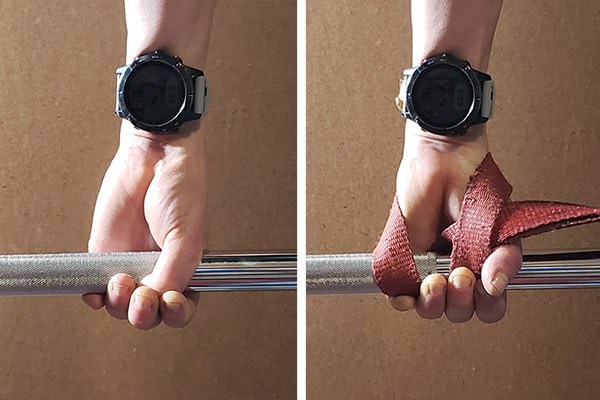
Hook grip vs. Straps
by stef bradford, PhD, SSC | December 26, 2023
All sorts of things show cycles of popularity and trends, from hairstyles, slang, avocado toast, and even Pantone’s color of the year (it is 13-1023 aka “peach fuzz” for 2024, if you care to know) outside the gym, to things like programming approaches, lifts to embrace or avoid, and equipment inside the gym. Fashions and trends are often harmless, or even fun, but letting them get in the way of making progress in the gym is silly.
Not too long ago, I had a conversation with an upcoming coach who was having trouble convincing a lifter to use straps for his heavy rack pulls. This trainee did not have a double-overhand grip strong enough to hold the bar and was wary of using an alternate grip due to the asymmetrical stress of that position. Instead, he was determined to tough it out and use the hook grip.
Apparently, he had fallen in with the recent, almost fetish-like worship of the hook grip for heavy pulls, and was determined to keep his lifting “pure” by avoiding the use of straps. Now, the hook grip is all well and good, and is needed to handle the acceleration of the bar in the clean and the snatch, but it’s not something you get bonus points for using – it’s just another tool.
Left, holding the bar with a hook grip where the thumb is used as a strap. Right, gripping the bar with a strap made from a salvaged come-along.
Straps are also a tool. And here’s the thing that I told the coach
to pass on to his lifter: they’re just a nylon hook grip. Or
a hook grip is just meat straps, if you prefer. In each case, the
squeeze of the thumb-side of the grip in the double-overhand position
is replaced. The straps drape around the wrist in the opposite
direction of the fingers and are trapped by the fingers to form a
very secure strapped-in grip. The thumb performs the same function in
the hook grip, as it is wrapped around the bar before being held in
place by the fingers to create the very secure thumb-strapped-in
grip.
Both strapping approaches require a bit of practice
to get right and to set securely. Both grips allow very heavy weights
to be held so that training can continue to progress, but there are a
few differences to consider.
The main advantages of the hook grip are that you don’t have to
remember to bring your straps with you, and you can use the grip in
competitions where straps are not permitted. The main downside is the
need to get accustomed to the pressure or even pain of the
compression on the thumb. This is significant because not everyone
has hands that work well for the hook grip – finger length and palm
thickness matter, and reps with this grip create wear and tear even
for those whose are suited to it.
In contrast, external straps distribute the load to the wrist,
avoiding the demands on the thumb seen in the hook grip. They allow a
lifter to continue to progress lifts in training and not be limited
by raw grip strength, or to pull even when injuries or degenerative
changes to the fingers would otherwise make it difficult. Properly
used, they’re basic equipment, not a crutch.
If you lift for any length of time, you’re likely to regularly use
all four grip approaches mentioned above: double-overhand for warmups
in deadlifts and assistance pulls; alternate grip, hook grip, or
straps for heavy deadlifts; hook grip or straps for cleans and
snatches; straps for assistance exercises like the rack pull or
snatch-grip deadlift. There might be times you switch from one to
another to continue to progress, or even to complete a workout.
Always focus on the goal of your training and don’t let yourself
get distracted by the latest motivations of the herd.
Discuss in Forums
Credit : Source Post







